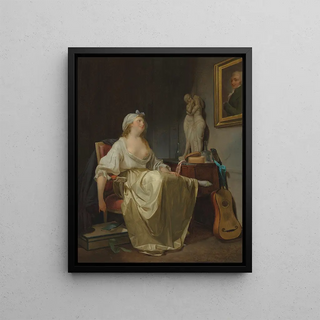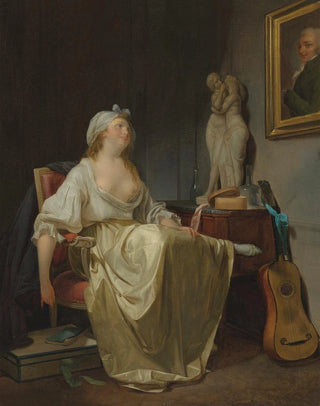Art print | Before the toilette - Louis Léopold Boilly


View from behind

Frame (optional)
The artwork "Before the toilette" by Louis Léopold Boilly, painted in the early 19th century, offers a window into the intimacy and delicacy of the customs of its time. This canvas, capturing a suspended moment in time, invites the viewer to immerse themselves in the daily life of a woman engaged in beauty rituals. With impressive mastery of light and shadow, Boilly manages to create an atmosphere that is both intimate and elegant, where every detail appears carefully orchestrated to reveal the beauty of his subject. The scene, imbued with sensuality, evokes a certain visual poetry that transcends eras and continues to delight those who linger on it.
Style and uniqueness of the artwork
Boilly's style is distinguished by its refined realism and keen sense of observation. In "Before the toilette," he succeeds in capturing not only the physical appearance of the woman but also the emotion emanating from this moment of preparation. The delicate colors, silky textures of the clothing, and soft light caressing the model's face testify to exceptional craftsmanship. The artwork is characterized by a harmonious composition, where each element, from the mirror to the dressing table, contributes to the visual storytelling. Boilly, a true master of the genre, manages to transform a mundane scene into a lively work of art, thus revealing the hidden beauty of everyday gestures.
The artist and his influence
Louis Léopold Boilly, born in 1761, is an emblematic artist of the neoclassical movement and early Romanticism. His innovative approach to genre painting influenced many contemporaries and paved the way for a new way of depicting daily life. Boilly skillfully captured the spirit of his time, blending realism with a touch of Romantic sensitivity. His work, rich in detail and emotion, left a lasting impression and continues to inspire artists today. Through his paintings, he immortalized small stories of life, paying tribute to the beauty of fleeting moments and the complexity of human relationships.

Matte finish

View from behind

Frame (optional)
The artwork "Before the toilette" by Louis Léopold Boilly, painted in the early 19th century, offers a window into the intimacy and delicacy of the customs of its time. This canvas, capturing a suspended moment in time, invites the viewer to immerse themselves in the daily life of a woman engaged in beauty rituals. With impressive mastery of light and shadow, Boilly manages to create an atmosphere that is both intimate and elegant, where every detail appears carefully orchestrated to reveal the beauty of his subject. The scene, imbued with sensuality, evokes a certain visual poetry that transcends eras and continues to delight those who linger on it.
Style and uniqueness of the artwork
Boilly's style is distinguished by its refined realism and keen sense of observation. In "Before the toilette," he succeeds in capturing not only the physical appearance of the woman but also the emotion emanating from this moment of preparation. The delicate colors, silky textures of the clothing, and soft light caressing the model's face testify to exceptional craftsmanship. The artwork is characterized by a harmonious composition, where each element, from the mirror to the dressing table, contributes to the visual storytelling. Boilly, a true master of the genre, manages to transform a mundane scene into a lively work of art, thus revealing the hidden beauty of everyday gestures.
The artist and his influence
Louis Léopold Boilly, born in 1761, is an emblematic artist of the neoclassical movement and early Romanticism. His innovative approach to genre painting influenced many contemporaries and paved the way for a new way of depicting daily life. Boilly skillfully captured the spirit of his time, blending realism with a touch of Romantic sensitivity. His work, rich in detail and emotion, left a lasting impression and continues to inspire artists today. Through his paintings, he immortalized small stories of life, paying tribute to the beauty of fleeting moments and the complexity of human relationships.






